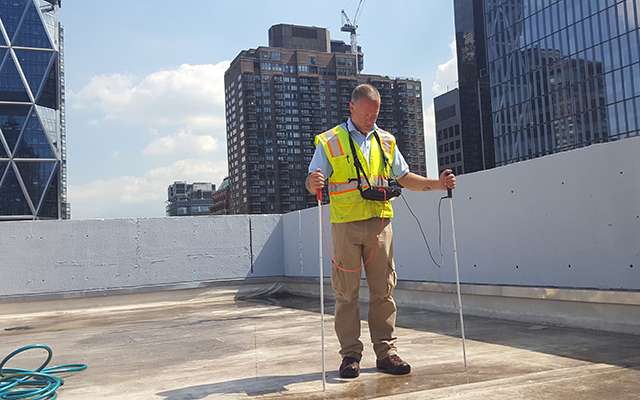Flat roofs can be significant weak points in buildings because they’re regularly exposed to water, snow, and debris. Detecting minor leaks before they become severe is critical for minimizing property damage and costly repairs. Below, we’re going to discuss what high-voltage leak detection is, its applications, and four reasons you should have it done on your building’s flat roof.
What Is High-Voltage Leak Detection?
High-voltage leak detection is a non-invasive scanning method for roofing material that can help pinpoint weak areas that have started to leak. During detection, a technician passes a metal bristle broom or brush with a high-voltage (yet very low amperage) over the entire waterproofing membrane. When a breach is detected, the test equipment will deliver a signal that the current has passed through the roof to the conductive reference below.
When Is It Used?
High-voltage leak detection technology is most often applied on dry, flat (or low sloped roofs. It can be used to scan horizontal and vertical sections, and it offers a highly accurate solution for leak detection that doesn’t involve flood testing the roof and potentially causing damage. It’s an excellent choice for older roofs that may not stand up to flood testing, newer roofs that may only have small leaks not detectable by other scanning methods, and roofing materials such as TPO, PVC, and Fluid Applied. HV testing is especially accurate above all other testings when there is severe damage such as dozens or even hundreds of tiny holes.
Below are the top four reasons to choose this type of testing for your building’s roof.
1 – Requires Little to No Water
While other roof testing methods require potentially dangerous volumes of water, recent rainfall, or roof wetting, high-voltage detection needs NO water to be pumped up to your roof. It’s capable of detecting even the slightest intrusion, which doesn’t require the addition of water.
2 – Can Test Horizontal and Vertical Slopes
Other detection methods can be used to test the flat areas of your roof, but high-voltage testing can be used to scan vertical sections as well. This scanning method allows you to test your entire roof for leaking, offering a better picture of your whole roof’s integrity.
3 – Can Pinpoint the Location of a Leak
Unlike flood testing, high-voltage leak detection provides a clear picture of precisely where the leaks in your roof are with pinpoint accuracy.
4 – Allows You To Repair Only the Damaged Area
An added benefit of pinpointing a leak is having the opportunity to focus only on repairing damaged areas of your roof. High-voltage testing can identify leaking material and indicate the smallest portions possible that need to be fixed, ultimately lowering your repair cost.
High-voltage leak detection presents a highly accurate, non-destructive and low-risk scanning method for finding leaks in any portion of your roof. It can uncover even the smallest of leaks and let you focus on areas that need repair, lowering your renovation cost.
When you’re ready to take advantage of this testing on your building’s flat roof, contact one of our highly-trained leak detection experts to learn more about how it can save you money and time, and reduce potential property damage.

